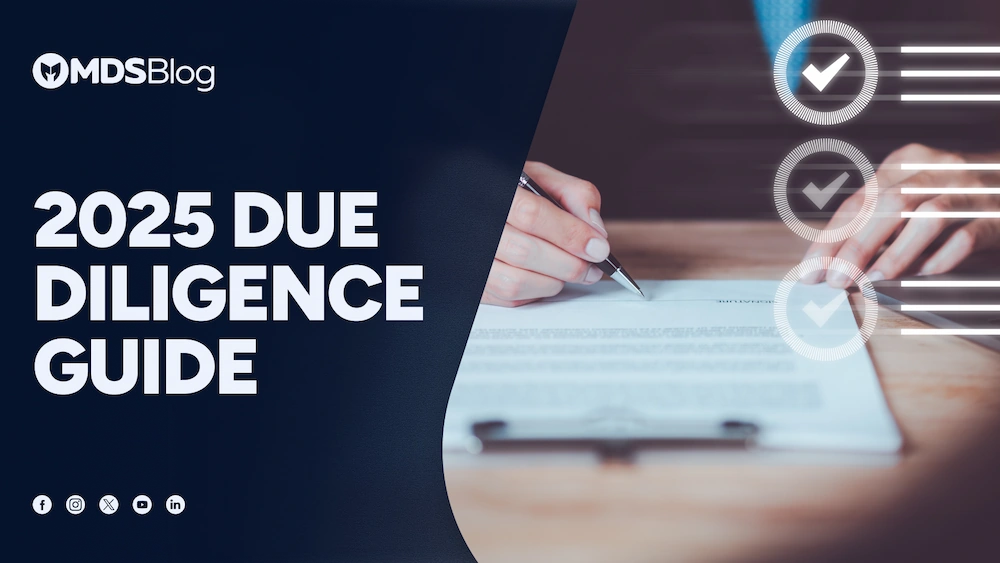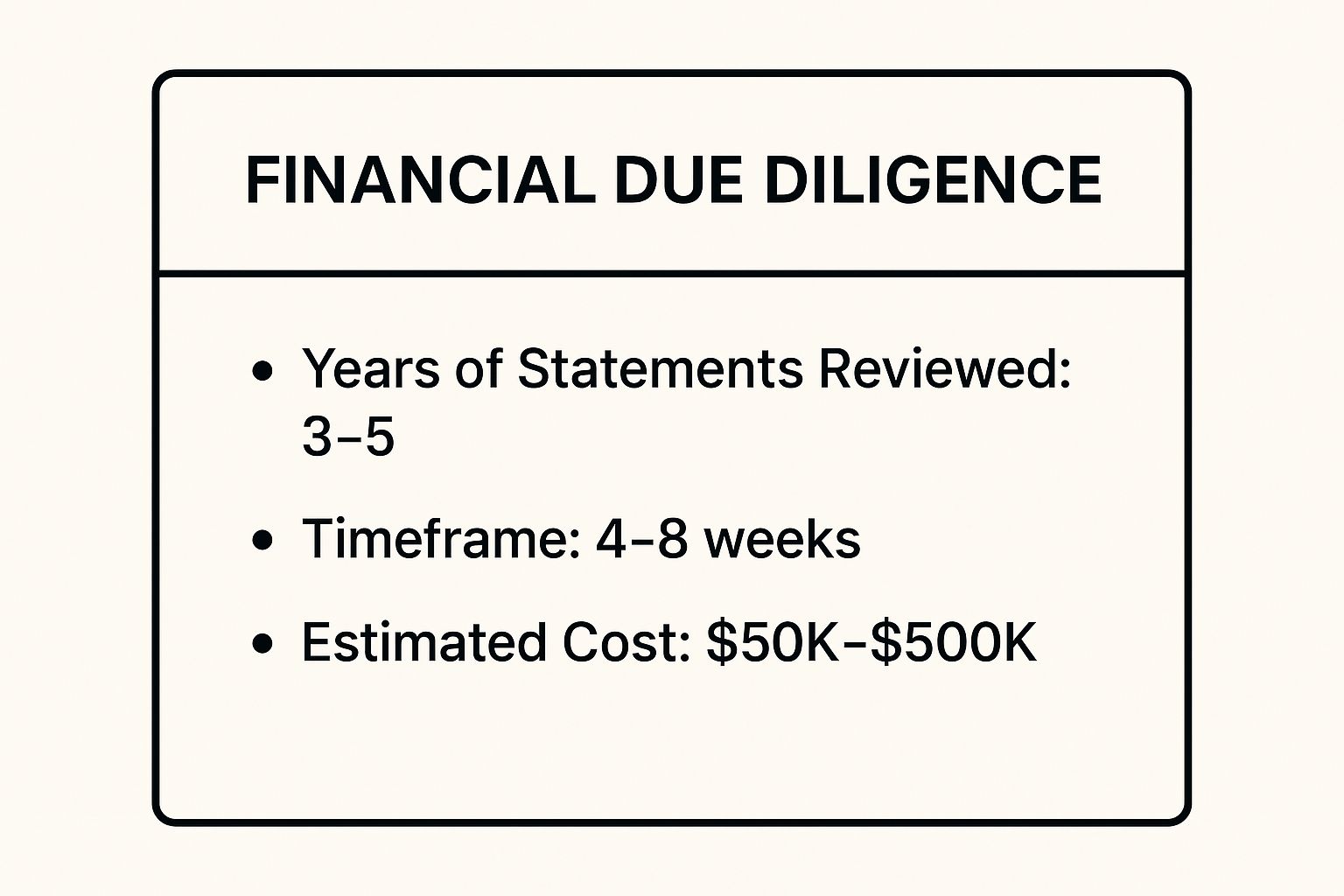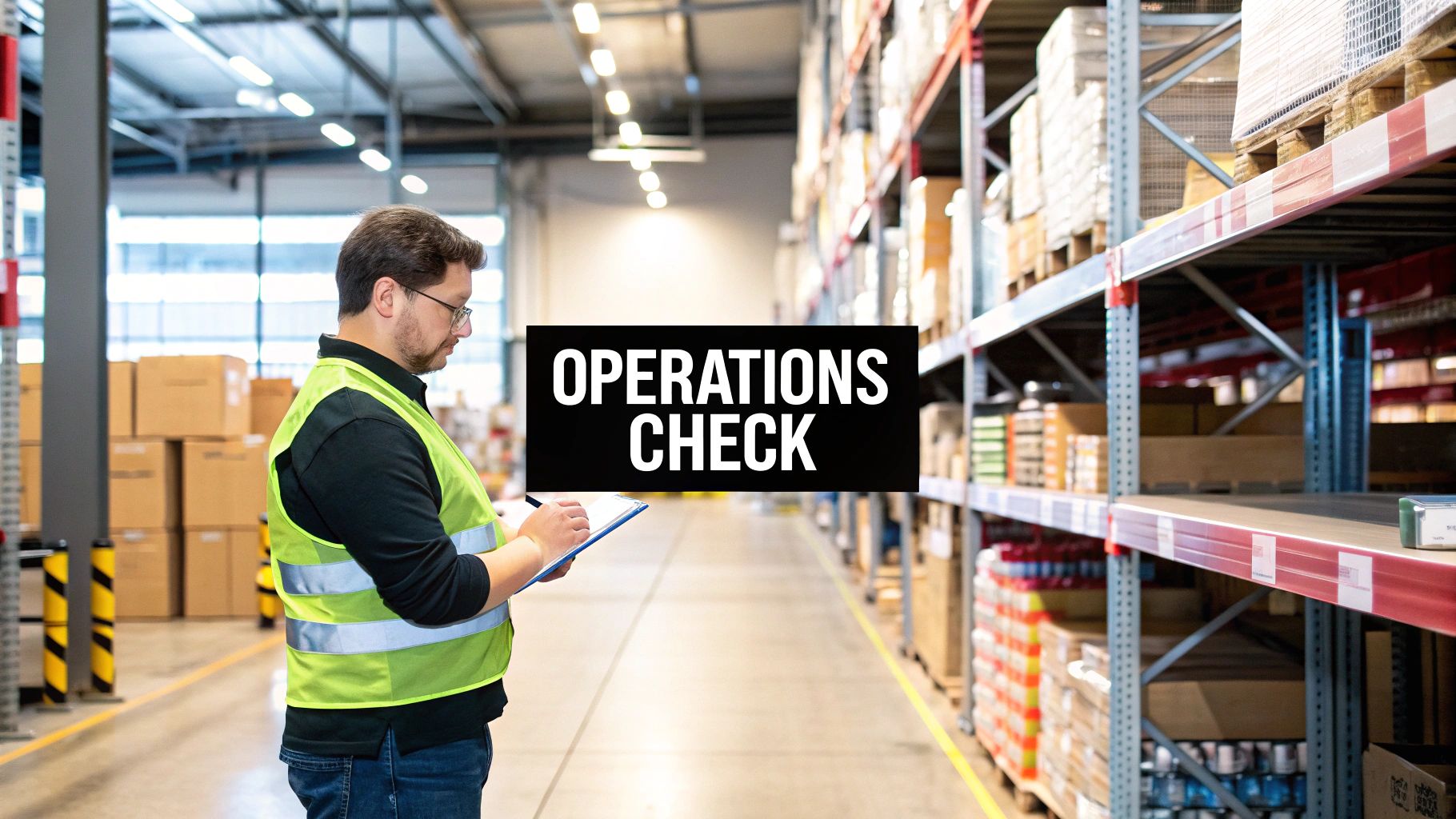Stay Updated with Everything about MDS
Thank you! Your submission has been received!
Oops! Something went wrong while submitting the form.

Chilat Doina
October 15, 2025
Embarking on a business acquisition is one of the highest-stakes moves an entrepreneur can make. Get it right, and you accelerate growth exponentially. Get it wrong, and the consequences can be catastrophic. The single greatest determining factor between a successful deal and a costly failure is the quality of your due diligence process. A superficial review leaves you vulnerable to hidden liabilities, inflated valuations, operational nightmares, and cultural clashes that can sink the entire investment before it ever has a chance to deliver returns.
This isn't just about ticking boxes; it's about uncovering the complete, unvarnished truth of the business you intend to buy. A robust due diligence checklist acquisition acts as your x-ray, revealing the internal health of the company beyond the polished pitch deck and optimistic projections. It validates the seller's claims, identifies potential deal-breakers, and provides the critical data needed to negotiate a fair price and structure a deal that protects your interests.
In this comprehensive guide, we will break down the eight essential pillars of a thorough investigation. From scrutinizing financial statements and legal contracts to assessing operational workflows and technological infrastructure, each section is designed to be actionable and exhaustive. We will equip you with the specific questions to ask and the critical documents to request across the entire spectrum of due diligence. This structured approach ensures you de-risk your deal, confirm the strategic fit, and lay the groundwork for a seamless and successful post-acquisition integration. Let's begin the deep dive.
Financial due diligence is the cornerstone of any acquisition, serving as a meticulous investigation into a target company's financial health and stability. This process moves beyond the surface-level numbers presented in an initial pitch deck, aiming to validate the seller's financial claims and uncover potential risks. It involves a deep dive into historical financial statements, accounting policies, revenue quality, cash flow patterns, debt structures, and working capital requirements.
The core objective is to ensure the company's financial reality aligns with its reported performance. A thorough financial review can confirm the valuation, identify unrecorded liabilities, or reveal unsustainable revenue practices, directly impacting the final purchase price and deal structure. This step is critical in any due diligence checklist for acquisition, as its findings can either validate a strategic investment or prevent a catastrophic financial mistake.
Without rigorous financial scrutiny, an acquirer is essentially flying blind. The infamous case of Hewlett-Packard's 2011 acquisition of Autonomy serves as a stark warning. A failure to conduct adequate financial due diligence led to an $8.8 billion writedown after significant accounting improprieties were discovered post-acquisition. Conversely, when Microsoft purchased LinkedIn in 2016, their extensive financial review confirmed the platform's strong growth trajectory and user engagement metrics, justifying the $26.2 billion price tag and paving the way for a successful integration.
This process provides an unbiased assessment of a company’s earnings quality. It helps you understand if profits are driven by sustainable, core operations or propped up by one-time events, aggressive accounting, or other non-recurring items.
To execute financial due diligence effectively, focus on precision and professional expertise.
The following infographic summarizes the typical scope of a comprehensive financial due diligence process.

As the data shows, this is a significant undertaking, often requiring a review of 3-5 years of financials over a 4-8 week period, with costs that reflect its depth and importance.
Legal due diligence is a comprehensive investigation into the legal standing and potential liabilities of a target company. This crucial process scrutinizes corporate structure, governance documents, material contracts, intellectual property rights, ongoing litigation, regulatory compliance, and employment agreements. It aims to identify and assess legal risks that could impact the company's value, operations, or create post-acquisition liabilities for the buyer.

The primary goal is to ensure the acquirer is not inheriting unforeseen legal problems, from a costly lawsuit to invalid patents. A meticulous legal review, a non-negotiable part of any due diligence checklist for acquisition, can uncover "ticking time bombs" like change-of-control clauses that could void key customer contracts upon closing. It also verifies that the seller actually owns the assets they claim to be selling, free and clear of encumbrances. The process of identifying and mitigating these risks is closely tied to ensuring you have the right protections in place, something you can explore further by understanding more about business insurance for ecommerce.
Ignoring legal due diligence is a high-stakes gamble with severe consequences. When Google attempted to acquire Groupon in 2010 for a reported $6 billion, legal due diligence played a key role in the deal's collapse by revealing significant issues with merchant contracts and accounting practices. In contrast, Amazon’s 2017 acquisition of Whole Foods required an incredibly swift yet thorough legal review of leases for over 400 stores and complex supplier contracts, which was successfully completed, enabling the $13.7 billion deal to close smoothly.
This process provides clarity on the legal and structural integrity of the business. It confirms ownership, identifies contractual obligations you will inherit, and quantifies potential legal exposures, allowing you to negotiate protections like indemnities or adjust the purchase price accordingly.
Effective legal due diligence requires a systematic approach led by specialized legal counsel.
Operational due diligence assesses the inner workings of the target company, examining how it functions on a day-to-day basis. This crucial step investigates everything from supply chains and production capabilities to internal processes and the IT systems that support them. The goal is to verify that the company’s operational infrastructure can sustainably support its financial performance and strategic goals.
This analysis uncovers the real-world efficiency, scalability, and potential risks hidden within the business operations. A comprehensive operational review can identify significant cost-saving synergies, reveal critical dependencies on key suppliers, or expose outdated technology that will require substantial investment. As a key component of any due diligence checklist for acquisition, this process ensures the acquirer understands not just what the business earns, but how it earns it.

Neglecting operational details can lead to disastrous integration failures. For example, after Boeing acquired Aviall in 2006, insufficient operational due diligence resulted in significant integration challenges and underperformance, highlighting the risks of overlooking a target's core processes. In contrast, when Kraft merged with Heinz in 2015, a detailed operational review identified an estimated $1.5 billion in synergies through supply chain optimization and manufacturing consolidation, a key driver of the deal's value.
This process provides a clear roadmap for post-acquisition integration. By understanding the target's systems, processes, and culture, you can plan for a smoother transition, mitigate operational disruptions, and start realizing value from day one.
To execute operational due diligence effectively, you must go beyond the boardroom and get an on-the-ground perspective.
The following video from leading experts provides further context on the strategic importance of this phase.
By thoroughly vetting the target's operational framework, you can confirm its ability to deliver on its promises and build a solid foundation for long-term growth.
Commercial due diligence acts as a forward-looking reality check on the target company’s market viability and growth potential. While financial diligence verifies past performance, commercial diligence assesses the future, scrutinizing the company's position within its market, its competitive landscape, the strength of its customer relationships, and the overall sustainability of its business model. It answers the critical question: can this business realistically achieve the growth and revenue figures projected in its business plan?
The primary goal is to validate the strategic rationale behind the acquisition. It involves a deep analysis of market trends, customer behavior, and competitive threats to confirm that the target's value proposition is strong and defendable. A thorough commercial review is a vital part of any due diligence checklist for acquisition, as it provides the context behind the numbers and determines if the expected synergies and market share gains are truly achievable.
Neglecting commercial diligence can lead to acquiring a business with a declining market position or a flawed business model. Microsoft's 2014 acquisition of Nokia's phone business is a cautionary tale; a failure to fully grasp the shifting competitive landscape and Nokia's weakened brand perception led to a massive $7.6 billion writedown. In contrast, when Unilever acquired Dollar Shave Club in 2016, their extensive commercial due diligence validated the strength of the subscription model, high customer lifetime value, and brand loyalty, justifying the $1 billion price and ensuring a successful market entry.
This process provides an objective view of the company’s real-world commercial traction. It helps you understand if the business has a loyal customer base, a strong competitive moat, and a product that truly fits the market's evolving needs, rather than one that is losing relevance.
To execute commercial due diligence effectively, you must go beyond the company’s internal data and engage directly with its market.
Technology and IT due diligence evaluates a target company's entire technology stack, from its infrastructure and proprietary software to its cybersecurity posture and digital capabilities. This process is far more than an inventory of assets; it's a critical assessment of the technology's role in driving revenue, its scalability, and its potential to create post-acquisition integration hurdles or security liabilities. It involves a deep dive into software architecture, technical debt, IT operational costs, data management practices, and the talent of the technology team.
The primary goal is to understand the risks, costs, and opportunities embedded within the target's technology. A comprehensive review can reveal outdated systems that require massive capital investment, uncover significant security vulnerabilities, or confirm the value of a unique technological asset. This analysis is a non-negotiable part of any modern due diligence checklist for acquisition, as technology is often the core engine of a company's competitive advantage.
Ignoring technology due diligence is a recipe for disaster in the digital age. When Verizon acquired Yahoo in 2016, a failure to initially uncover massive data breaches ultimately led to a $350 million reduction in the purchase price and significant reputational damage. In contrast, IBM's 2019 acquisition of Red Hat was a success largely built on meticulous technology due diligence. Their deep review validated the power and scalability of Red Hat's open-source, hybrid cloud platform, justifying the $34 billion price tag and creating a clear path for strategic integration.
This process provides a clear-eyed view of a company's technological health. It helps you determine if the tech is a scalable asset that can support future growth or a fragile liability riddled with technical debt and security risks.
To conduct effective technology due diligence, a blend of specialized expertise and structured analysis is essential.
Human resources and cultural due diligence is a critical evaluation of a company's workforce, organizational culture, and people-related liabilities. This process goes beyond headcount and payroll, diving into employee relations, compensation structures, key person dependencies, and the intangible yet powerful element of workplace culture. The primary goal is to assess the human capital asset being acquired and identify potential integration challenges that could derail the deal's value post-close.
Often overlooked in favor of financial metrics, this area is where many acquisitions fail. A toxic culture, an overpaid and underperforming team, or unresolved labor disputes can be far more costly than balance sheet liabilities. This step in the due diligence checklist for acquisition is crucial for understanding if the two organizations can truly merge into a cohesive and productive single entity, which is foundational for building high-performing teams after the transaction closes.
Ignoring the human element can lead to catastrophic value destruction. The infamous AOL-Time Warner merger is a textbook case of cultural clash; the aggressive, fast-paced internet culture of AOL was completely incompatible with the traditional, hierarchical media environment of Time Warner, leading to an exodus of talent and a staggering $200 billion loss in value. In contrast, when Disney acquired Pixar in 2006 for $7.4 billion, they made a deliberate effort to protect Pixar’s unique creative culture, which was identified as its most valuable asset during due diligence. This careful cultural preservation allowed Pixar to continue flourishing and has been hailed as one of the most successful acquisitions in history.
This process uncovers hidden risks like pending employee lawsuits, high employee turnover, or a lack of leadership depth. It also provides a roadmap for successful integration by highlighting cultural differences that need to be managed carefully.
To conduct effective HR and cultural due diligence, a mix of qualitative and quantitative analysis is required.
Tax due diligence is a highly specialized review of a target company's tax history, compliance status, and potential liabilities. This process moves beyond simply confirming that tax returns have been filed; it scrutinizes the tax positions taken by the company to uncover hidden risks and identify opportunities for structural optimization. The review covers everything from federal and state income taxes to sales tax, payroll tax, international transfer pricing, and the status of tax attributes like Net Operating Losses (NOLs).
The core objective is to ensure there are no looming, unrecorded tax liabilities that could transfer to the buyer post-acquisition. A thorough tax review is a critical component of any due diligence checklist for acquisition, as its findings can dramatically alter the deal's value, structure, and long-term financial viability. It protects the acquirer from inheriting costly tax disputes and helps craft the most tax-efficient transaction structure possible.
Ignoring tax due diligence is a recipe for costly surprises. An acquirer could unknowingly become responsible for years of unpaid sales tax or significant penalties from an aggressive tax position taken by the previous owner. A prime example of strategic tax diligence was Medtronic's 2015 acquisition of Covidien. The deal was structured as a tax inversion, moving the combined company's headquarters to Ireland, a move informed by extensive tax analysis that was projected to save billions in future taxes.
This process provides a clear picture of a company’s tax risk profile. It helps an acquirer understand if the target has been compliant in all jurisdictions where it operates and whether its tax strategies are sustainable. Failing to assess this can have serious consequences, as unseen tax issues can erode the expected return on investment.
To execute tax due diligence effectively, a specialized and forward-looking approach is essential.
Environmental due diligence is a specialized investigation into a company's environmental compliance and potential liabilities. This process assesses risks associated with past and present operations, including soil and groundwater contamination, hazardous materials management, and adherence to environmental laws. It is particularly critical for businesses in manufacturing, real estate, energy, or any sector with a physical footprint, as overlooked environmental issues can result in massive, long-tail liabilities.
The primary goal is to identify and quantify environmental risks that could lead to significant cleanup costs, regulatory fines, or operational disruptions post-acquisition. A thorough environmental assessment, a key part of any modern due diligence checklist for acquisition, can uncover hidden problems that directly affect the target's valuation, negotiate liabilities in the purchase agreement, and prevent the buyer from inheriting a costly environmental catastrophe.
Ignoring environmental risks can be financially devastating. General Electric’s decades-long, billion-dollar cleanup of PCB contamination in the Hudson River is a prime example of how historical environmental liabilities can haunt a company for generations. On the other hand, when BP acquired Amoco in 1998, its comprehensive due diligence identified over $200 million in potential cleanup liabilities, which were then addressed and allocated within the purchase agreement, protecting BP from unforeseen costs.
This process provides a clear picture of a company’s environmental footprint and regulatory standing. It moves beyond simple compliance checks to evaluate the potential for future liabilities, ensuring the acquirer understands the full scope of risks they are assuming with the transaction.
Executing environmental due diligence requires specialized expertise and a systematic approach to risk identification.
Due Diligence TypeImplementation Complexity 🔄Resource Requirements ⚡Expected Outcomes 📊Ideal Use Cases 💡Key Advantages ⭐Financial Due DiligenceHigh: 4-8 weeks, extensive data collectionHigh: costly ($50K–$500K+), requires financial expertsValidates financials, uncovers risks & liabilitiesAcquisitions needing precise valuation & risk checkObjective validation, risk identification, pricing accuracyLegal Due DiligenceVery High: 6-12 weeks, complex document reviewVery High: legal experts, potentially $100K–$1M+ feesIdentifies legal risks, ensures asset/contract transferDeals with complex contracts, regulatory oversightLegal risk mitigation, IP protection, litigation exposure insightsOperational Due DiligenceMedium-High: 4-6 weeks, process & site reviewsModerate: operations team involvement, consulting feesReveals operational risks, efficiency & synergyAssessing operational execution and scalabilityOperational risk insight, synergy & cost-saving opportunitiesCommercial Due DiligenceMedium: 4-8 weeks, market & customer researchModerate-High: market research, expert analystsValidates market position & growth projectionsStrategic acquisitions aiming for growth or repositioningMarket risk assessment, revenue potential validationTechnology and IT Due DiligenceMedium: 3-6 weeks, technical system analysisModerate-High: specialized IT consultants, testing costsIdentifies IT risks, security gaps, integration issuesTech-heavy deals requiring cybersecurity & integrationTech risk mitigation, cost quantification, IP uncoveringHR and Cultural Due DiligenceMedium: 4-6 weeks, surveys & interviewsModerate: HR experts, employee surveysReveals cultural fit, retention risks & workforce qualityDeals with high people-impact and cultural integrationIdentifies key person risks, cultural compatibility, integration costTax Due DiligenceHigh: 4-8 weeks, detailed tax analysisHigh: tax advisors, costly ($75K–$300K+)Identifies tax liabilities, optimizes transaction structureDeals with complex tax jurisdictions & structuresTax risk identification, transaction tax efficiency, planningEnvironmental Due DiligenceMedium: 2-8 weeks, assessments & site testingModerate-High: environmental consultants, testing feesDetects environmental liabilities & complianceIndustrial, manufacturing, real estate transactionsLiability protection, cleanup cost quantification, regulatory compliance
Navigating the complexities of an acquisition is a high-stakes endeavor, and the journey from initial interest to a successful closing is paved with meticulous investigation. The comprehensive due diligence checklist acquisition process we've detailed is not merely a procedural hurdle; it is the strategic foundation upon which a successful integration and long-term value creation are built. It's the mechanism that transforms a promising opportunity into a quantifiable, defensible investment.
By methodically working through financial, legal, operational, and commercial diligence, you move beyond the seller’s narrative and into the objective reality of the business. You uncover the true state of the balance sheet, the hidden liabilities in contracts, the bottlenecks in the supply chain, and the genuine sentiment of the customer base. This isn't about finding reasons to walk away from a deal; it’s about gathering the intelligence needed to structure the right deal with confidence.
The true power of this process lies in its application. Each discovery, whether positive or negative, is a critical data point that informs your strategy.
Key Insight: Due diligence is an offensive tool, not just a defensive one. It validates your investment thesis, reveals untapped growth levers, and provides the blueprint for a seamless and profitable integration.
The eight distinct areas of diligence, from Tax and Environmental to IT and Human Resources, are not isolated silos. Their findings interconnect to form a holistic, three-dimensional view of the target business. A legal review might uncover a pending lawsuit, the potential cost of which directly impacts your financial models. An IT assessment might reveal outdated systems, which explains the operational inefficiencies you discovered earlier.
Your task is to connect these dots. A fragmented approach can lead to critical oversights. To ensure a comprehensive approach and mitigate risks, refer to an 8-Point Due Diligence Checklist for Acquisitions that guides you through critical steps. This structured methodology ensures no stone is left unturned, empowering you to make a final decision based on a complete and unvarnished picture.
Ultimately, a well-executed due diligence process gives you control. It allows you to anticipate challenges, quantify risks, and confirm opportunities. You will enter negotiations armed with facts, not assumptions, and you will sign the final papers with a clear vision for the future. The effort invested in this critical phase is the single greatest predictor of a successful acquisition, ensuring the deal you close is the one you actually intended to make.
Ready to connect with elite entrepreneurs who navigate high-stakes acquisitions and build 7, 8, and 9-figure brands? Join Million Dollar Sellers, an exclusive, vetted community where top Amazon and ecommerce business owners share advanced strategies on M&A, operations, and scaling. Elevate your network and your business by applying to Million Dollar Sellers today.
Join the Ecom Entrepreneur Community for Vetted 7-9 Figure Ecommerce Founders
Learn MoreYou may also like:
Learn more about our special events!
Check Events